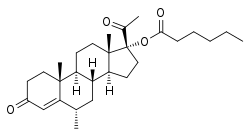Medroxyprogesterone caproate
Medroxyprogesterone caproate (MPC) is a progestin and a progestogen ester which was synthesized in 1958 but was never marketed.[1][2] It has been confused with hydroxyprogesterone caproate (OHPC) and medroxyprogesterone acetate (MPA) in a number of publications.[3][4][5][6][7][8][9][10][11][12] In addition to MPA and OHPC, analogues of MPC include chlormadinone caproate, gestonorone caproate, megestrol caproate, and methenmadinone caproate.
 | |
| Clinical data | |
|---|---|
| Other names | MPC; Medroxyprogesterone capronate; Medroxyprogesterone hexanoate; 6α-Methyl-17α-hydroxyprogesterone hexanoate; 6α-Methyl-17α-hydroxypregn-4-ene-3,20-dione hexanoate |
| Routes of administration | Intramuscular injection |
| Drug class | Progestogen; Progestin; Progestogen ester |
| Identifiers | |
| |
| CAS Number | |
| PubChem CID | |
| ChemSpider | |
| UNII | |
| CompTox Dashboard (EPA) | |
| Chemical and physical data | |
| Formula | C28H42O4 |
| Molar mass | 442.640 g·mol−1 |
| 3D model (JSmol) | |
| |
| |
References
- Babcock, John C.; Gutsell, Erwin S.; Herr, Milton E.; Hogg, John A.; Stucki, Jacob C.; Barnes, Lester E.; Dulin, William E. (1958). "6α-Methyl-17α-hydroxyprogesterone 17-acylates; a new class of potent progestins". Journal of the American Chemical Society. 80 (11): 2904–2905. doi:10.1021/ja01544a079. ISSN 0002-7863.
- Barton, D. H. R.; Taylor, W. C. (1958). "510. Photochemical transformations. Part IV. The photochemistry of prednisone acetate". Journal of the Chemical Society (Resumed): 2500. doi:10.1039/jr9580002500. ISSN 0368-1769.
- Pasqualini JR, Paris J, Sitruk-Ware R, Chetrite G, Botella J (April 1998). "Progestins and breast cancer". J. Steroid Biochem. Mol. Biol. 65 (1–6): 225–35. doi:10.1016/S0960-0760(98)00028-4. PMID 9699877.
- Pasqualini JR, Ebert C (June 1999). "Biological effects of progestins in breast cancer". Gynecol. Endocrinol. 13 Suppl 4: 11–9. doi:10.1080/gye.13.s4.11.19. PMID 12227897.
- Pasqualini JR, Chetrite GS (December 2010). "Biological responses of progestogen metabolites in normal and cancerous human breast". Horm Mol Biol Clin Investig. 3 (3): 427–35. doi:10.1515/HMBCI.2010.066. PMID 25961215.
- Lantta M, Kahanpää K, Kärkkäinen J, Lehtovirta P, Wahlström T, Widholm O (June 1984). "Estradiol and progesterone receptors in two cases of endometrial stromal sarcoma". Gynecol. Oncol. 18 (2): 233–9. doi:10.1016/0090-8258(84)90031-3. PMID 6735266.
- Saul Bernard Gusberg; Hugh M. Shingleton; Gunter Deppe (1988). Female genital cancer. Churchill Livingstone. p. 374. ISBN 978-0-443-08525-3.
- Proceedings. American Cancer Society and National Cancer Institute of the U.S. Public Health Service, Federal Security Agency. 1970. p. 376.
- David H. Nichols; John R. Evrard (1985). Ambulatory Gynecology. Harper & Row. p. 518. ISBN 978-0-06-141815-0.
- Louis Sanford Goodman; Alfred Goodman Gilman (1996). Goodman & Gilman's the Pharmacological Basis of Therapeutics. McGraw-Hill, Health Professions Division. pp. 1427, 1823, 1858. ISBN 978-0-07-026266-9.
- Endokrinologie. Johann Ambrosius Barth Verlag. 1969. p. 431.
- McKinnon AO, Tarrida Del Marmol Figueroa S, Nobelius AM, Hyland JH, Vasey JR. Failure of medroxyprogesterone caproate to maintain pregnancy in ovariectomised mares. Equine Vet J 1993; 25:158–160.
This article is issued from Wikipedia. The text is licensed under Creative Commons - Attribution - Sharealike. Additional terms may apply for the media files.